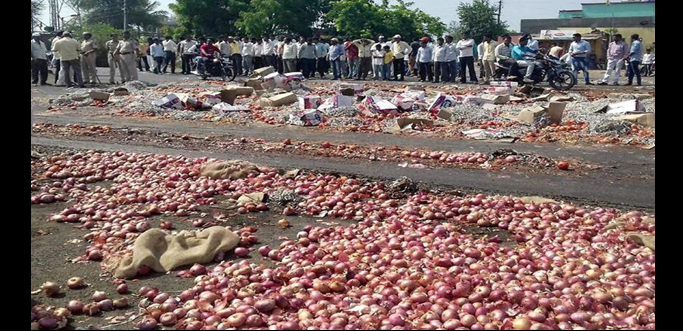Govt Vs Farmers: Fadnavis Tries to Break Strike, 21 Farmer Organisations Set to Unite in Maharashtra
THE CITIZEN BUREAU

MUMBAI: The fresh impetus for the farmers of Maharashtra and Madhya Pradesh to get back on the streets with their demands that the BJP governments in both states have been ignoring for years now, came from Uttar Pradesh where the new BJP Chief Minister Yogi Adityanath announced a loan waiver within days of taking the oath.
Fed up with the vacuous promises of their respective Chief Ministers, the farmers started the agitation afresh when a bumper crop and a great monsoon did not add to their coffers, and in reality kept these empty. A little village Puntamba in Nashik district of Maharashtra was the first to be ignited, with the farmers of this affected belt, deciding to renew the agitation for proper pricing of their produce, and for loan waivers. The refrain was : if the BJP can do it in UP, why is it not doing it for us in Maharashtra (and in Madhya Pradesh).
The farmers agitation spread in no time, with more and more villages joining in along with kisan outfits and political parties other than the BJP of course. This took the form of a blockade where the farmers decided not to allow vegetables and milk to reach the cities with a “let us see how they can manage without us.”
This despite a bumper crop, of toor dal in the affected areas. The farmers who were looking to make some money after drought years found that the price of the dal crashed from Rs 12000 to just Rs 3000. The government, after considerable pressure announced a fixed price of Rs 5000 plus but as the local leaders said, the government machinery was so inefficient and corrupt that even this price did not reach by now the badly impacted farmers. Hence the main demands of proper pricing for the produce and loan waivers.
Leaders like Raju Shetty and others who had been with the NDA came out of the fold to join the agitating farmers, with Shiv Sena jumping into the fray as well. The Congress, Nationalist Congress Party, as well as the Left parties, trade unions, kisan organisations have all now come in with the strike call of Wednesday leading to a huge meeting on Thursday where the plan is to set up a Coordination Committee to take this agitation forward. And link it with the agrarian distress in other states where the farmers are barely able to survive.
On the other side Chief Minister Devendra Fadnavis,like his counterpart in Madhya Pradesh, first tried to divide the farmers. Clearly responding to a fixed strategy at higher levels than his office Fadnavis tried to break the farmers unity---as did Chouhan---by singling out a kisan organisation, Kisan Kranti Dal, seen as close to the BJP. The representatives of this union met him, came out saying most of their demands had been met, and that they were calling off the agitation. As pointed out by The Citizen earlier, the same tactics were used by Chouhan to divide the agitating farmers in his state. Both have not succeeded at least till now.
This was resisted by the majority of farmers in Maharashtra, who rejected the claims made by the select group and announced the intention to continue the agitation. This was despite arrests and lathi charge on the farmers in Maharashtra, less than in Madhya Pradesh where eight were killed after the police resorted to firing. Internet services were snapped across the region in a bid to prevent the young farmers from using WhatsApp to rally others.
In Maharashtra, where farmers agitations have been part of the polity for decades now, there are several remnants of ertswhile organisations dotting the state. As are individuals. In the current stir the Shiv Sena has come in with full support for the farmers. The Congress with its kisan union is also an active participant, having organised a Sangharsh yatra for farmers rights a few months ago. The Left parties have been agitating through their kisan sabhas for the farmers who are set to lose 22000 acres for the development of a 700 km Nagpur-Mumbai highway, 50 per cent of this being fertile land. Huge demonstrations for this have been held, with little result.
All these strains have come together now in a huge show of solidarity. 21 farmers organisations will be meeting at Nashik to set up the coordination committee that is expected to oversee a united struggle. This is being seen as a crucial meeting, with efforts on by the state government to break the strike, or at least demoralise the farmers by ensuring that their effort to block milk and vegetables from reaching the cites does not work. The state is trying to get the same from Gujarat in the belief that this will break the back of the resistance, as the farmers cannot afford to stay away from their fields for long.
The government is working on the twin pronged divide and rule strategy, along with delaying tactics to break the sustainability factor. Aware of this the farmers groups are meeting to ensure unity, and develop a strategy based on the sustainability of prolonged agitation. As the farmers said, instead of working to meet the main demands that have crippled the agrarian sector, and particularly the districts of Pune, Nashik, Ahmednagar, Sapara, the state government is bent on breaking the back of the farmers strike.
The death of eight farmers in Madhya Pradesh has stoked new fires, and the agitation currently seems to have acquired new dimensions with the governments on the backfoot for now. As a senior Kisan Sabha leader said, “this is not a demand oriented struggle, it is a reflection of a deep agrarian crisis that needs a permanent solution.”



